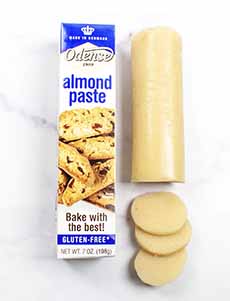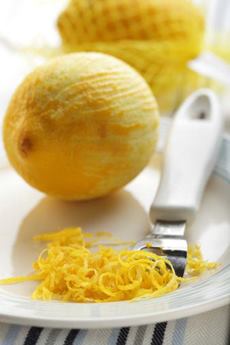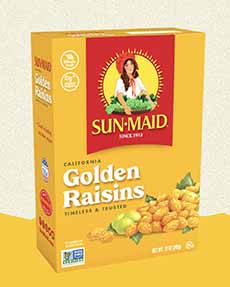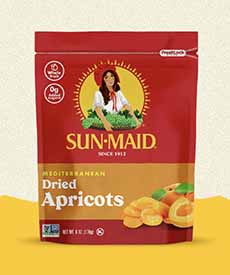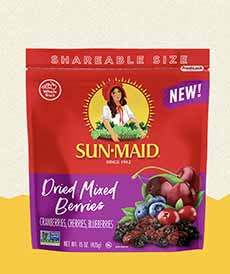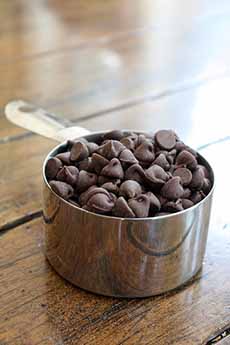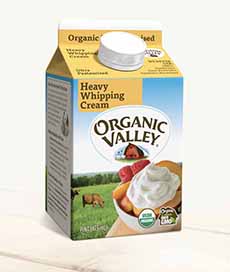Good-Bye Fruitcake, Hello Fruitcake Cookies Recipe
|
There are fruitcakes, some delicious, some unfortunate. They are a classic but polarizing holiday dessert. And then, there are fruitcake cookies, irresistible finger food that will remain popular far beyond the holidays. Sun-Maid, seller of popular dried fruits that go into fruitcakes (and many other recipes) during the holiday season—has formally announced an amicable break up with fruitcake. At some point, it’s time to move on, says Sun-Maid. So they enlisted top pastry chef Duff Goldman to think outside the cake pan. The recipe for his creation, Forget Fruitcake cookies, is below, using several of Sun-Maid’s dried fruits. Most of us have been eating Sun-Maid since childhood, starting with raisins. Today the line is very nicely expanded to include these dried fruits: We love to snack on the dried fruits, toss them onto or into pound cakes, ice cream and sorbet, and make a trail mix of assorted dried fruits and nuts. We also rehydrate the fruits into a kind of fruit relish. We combine the rehydrated Mediterranean Apricots, Dried Mixed Berries, Chopped Dates, Dried Mango, and Mixed Jumbo Raisins with a splash of Grand Marnier or white wine. (You need to chop the apricots and the mango.) Now, onto “Forget Fruitcake.” Duff Goldman created his “Forget Fruitcake” cookies. which are three-layer cookies filled with jam and iced with chocolate (photo #1), in the manner of Italian Rainbow Cookies (photo #2). These kits are designed to comfort you, no matter what or who you’re breaking up with this holiday season and will include Duff Goldman’s very own “Forget Fruitcake” cookie recipe, inspiring culinary creativity amidst this devastating split. We baked them on Friday and by Saturday they were all gone. Next steps: Bake a double bath and freeze what you don’t use. Prep time is 2 hours including baking time. 1. CHOP each pairing of dried fruit and place in individual bowls. Add ½ cup of boiling water to each bowl to soak and cook the dried fruits in individual batches. Cover and set aside. 2. HEAT the oven to 350°F. Line 3 quarter-sheet pans (13″ x 9″) with parchment. Overlap the parchment at opposite ends of the pan to create parchment “handles” to lift out the baked layers. Spray the parchment with cooking spray and set them aside. 3. CREAM the almond paste, butter, sugar, egg yolks, almond extract, orange zest, lemon zest, salt and spices. Beat with the paddle attachment of a stand mixer until light and fluffy. 4. ADD the flour in stages, scraping the bowl between each addition. Transfer the batter into three separate medium-sized bowls. 5. DRAIN the fruits, mash them thoroughly, and add each to one medium bowl of cake batter. Add a couple drops of food coloring to enhance the colors of each batch. 6. WHIP the egg whites until stiff peaks form. Fold ⅓ of the egg whites into each bowl. 7. SPREAD each batter onto a different prepared sheet pan and bake for about 11 minutes, rotating the pans halfway through. Cool on a wire rack. Once cooled, lift the layers from the pans using the parchment handles. 8. SPREAD the jam on the yellow and red layers. Stack the cakes (starting with yellow on the bottom, then red, then violet) on a piece of parchment on the back of a sheet pan. Place another sheet of parchment on top and then another sheet pan. Lean on the top sheet pan and gently press down the cakes. At this point you can cover the cake with plastic wrap and refrigerate for at least 4 hours, or overnight. 9. SLICE the cake stacks in long straight lines 1½-inches wide. Then cut the cake strips into 1½-inch squares. 10. SCALD the cream and add it to the chocolate to create a ganache. Cover and let the chocolate melt, then whisk it thoroughly into the cream. Smooth the ganache over the top sides. 11. DECORATE each piece with blanched almonds and thinly sliced apricots. Refrigerate for 20 minutes and they’re ready to serve. You can save time by icing the stacked cakes before you cut them, then slice them after the ganache hardens. They will be like the rainbow cookies in photo #2, less chocolaty than Duff’s version. But you don’t spend time icing three sides—just the top. Similarly, you can skip the double garnish on each piece, or just lay one garnish—an almond or an apricot slice—on top of each. We used both, alternating them so guests could take their pick. We love a good cup of black tea with our fruitcake, or a spice tea like Constant Comment (which is also available in a decaffeinated version and a green tea version). Port is the wine of choice, but other choices include: The earliest known recipe for fruitcake dates to ancient Rome, using pine nuts, pomegranate seeds, and raisins. By the Middle Ages, honey, preserved fruits, and spices had been added and the cake was enjoyed throughout Europe. Recipes varied widely by region. In the 16th century, sugar from the Caribbean—and the discovery that sugar could be used to preserve fruits—made fruitcakes more affordable and popular. Everything was delicious for a few centuries. But the mass production of prepared foods that followed World War II led to low-priced and not great-tasting fruitcakes. Following tradition, people gave them as Christmas gifts, but few recipients enjoyed eating them. Many of them re-gifted their fruitcakes; thus the joke from comedian Johnny Carson, that there was only one fruitcake in the world and it got passed from person to person. Bake yourself a really good fruitcake and see why it deserves its place among delicious Christmas foods. |
|
|
|
CHECK OUT WHAT’S HAPPENING ON OUR HOME PAGE, THENIBBLE.COM.
|
||


